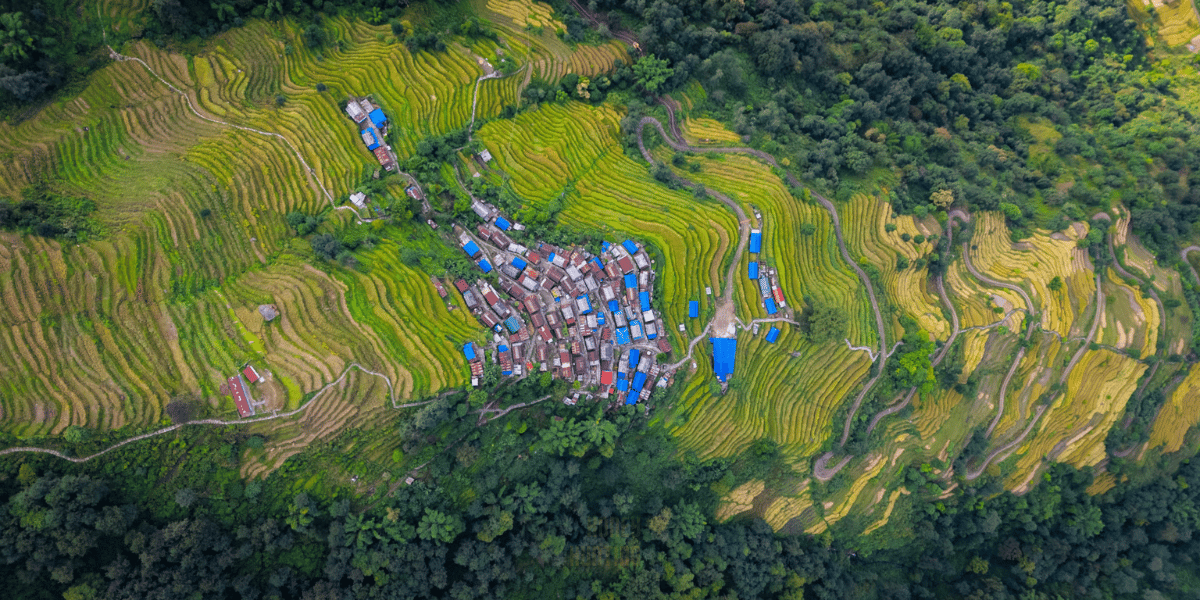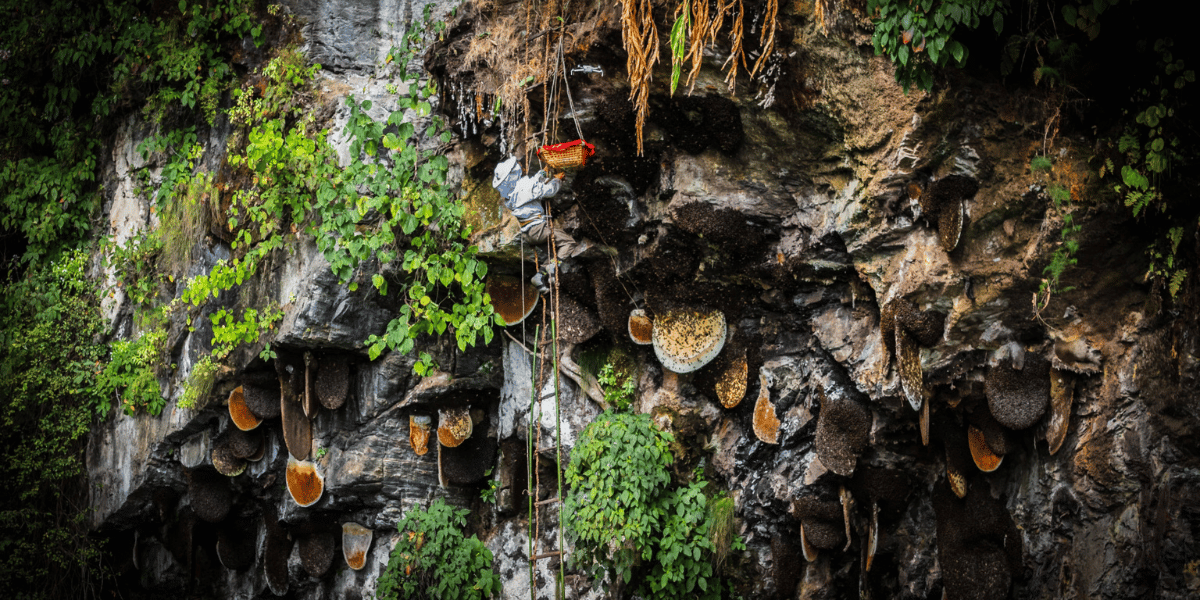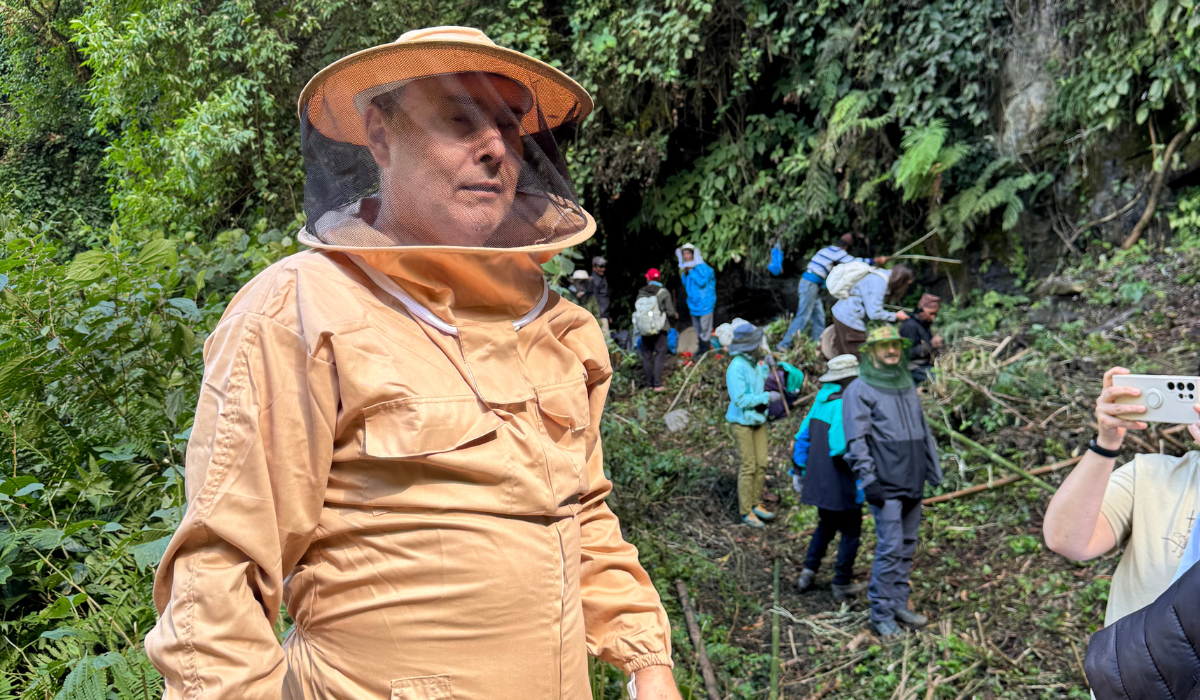Mad honey, better known as Himalayan Wild Mad honey, is a unique type of honey found in high-altitude regions of Nepal, particularly in districts like Lamjung, Kaski, Khotang and so on. Unlike the other sweet honey one might have tasted, mad honey possesses the unique taste of a rich sweet flavour with a bitter edge. It is harvested by the fearless honey hunters from the high cliffs, over 100 metres from the hive of the giant honey bees.
One might wonder, what makes mad honey mad? The secret lies in the grayanotoxin of rhododendron, which plays a major role in its formation. The nectar is collected by the giant Himalayan honey bees from the Apis Dorsata and Apis Laboriosa genus. Imagine a honey that can induce euphoria and hallucinations. The honey known for its medicinal benefits and some hallucinogenic effects has both fascinated and cautioned people for centuries.
It has held cultural, medicinal and spiritual significance among the indigenous communities, especially the Gurung people. The honey, which has been harvested using age-old techniques passed down through generations is traditionally used by the locals in small doses to treat conditions like hypertension, diabetes, abdominal pain and others. However, overdosing on this honey will cause side effects like dizziness, nausea, and cardiac complications. This blog, "Mad Honey in Nepal," discusses the science behind mad honey alongside the traditions following this rare gift from nature.
Mad Honey Hunting Locations
The location for the mad honey harvesting in Nepal is characterized by the remote location, steep cliffs, rugged terrain and dense forests. Primarily, it is found in the mid-hilly or himalayan regions where there are abundant rhododendron flowers, as the Himalayan giant honey bees feed on the nectar of these flowers. The most notable areas include Lamjung and Kaski, all situated within the Himalayan foothills of Nepal. Apart from Lamjung and Kaski, some of the other prime locations where the mad honey is found are Khotang, Gorkha, Myagdi and so on.

|
Lamjung |
|
Kaski |
|
Khotang |
|
Gorkha |
|
Myagdi |
|
Rasuwa |
Also Read: Honey Hunting in Lamjung
Honey Hunting in Nepal
Honey hunting is one of the ancient traditions of harvesting the honey by scaling the high cliffs by the indigenous community of Nepal. The special bee species, i.e Apis Laboriosa and Apis Dorsata build their nests at great heights, often on steep cliffs, thus providing the thrilling experience of watching the whole harvesting process. Different from collecting the honey from the domesticated bees, this process involves higher risk and has great cultural and spiritual significance. In this process, hunters climb up or step down cliff faces using bamboo rope ladders and then gather the honey using traditional aids, often without any protective gear.

Honey hunting, somewhat a perilous skill passed down through generations, has always been one hungry for existence; it is an initiation for the young men, a cultural activity that welds communities together, and a symbol of bravery and endurance. In recent years, it has found a special niche within the social life of these communities. This ancient practice creates a special relationship between humans and nature, where knowledge and courage play a vital role. Each year, several hundred tourists find their way into Nepal with their daring hearts just to see this long preserved tradition and get a taste of this unique honey. Some of the regions providing some rare views of this ancient practice are Kaski, Lamjung, Khotang, Gorkha, and Myagdi.
Health Benefits
The normal honey found in the market has its own benefits. However, this unique mad honey is regarded as more potent than other honey with high health benefits. The mad honey which has grayanotoxin and neurotoxic compounds in it, gives the mad honey its distinctive properties.
Traditionally the mad honey has been consumed in very small amounts for a range of claimed health benefits. These include relieving gastrointestinal issues like indigestion and ulcers and providing mild pain relief. Some traditional users also believe it helps to lower blood pressure and provide antimicrobial and antioxidant effects. Local communities have long valued it as a natural remedy, using it under strict traditional knowledge passed through generations.
|
Hypertension |
|
Diabetes |
|
Abdominal Pain |
|
Treatment of Gastric |
|
Coronary artery diseases |
|
Cold, Viral infections and so on. |
Health Risks and Effects
Along with the medicinal benefits, mad honey is also known for its toxicity and some side effects, especially when consumed more than the recommended doses. Even a slight number of higher doses can lead to symptoms such as nausea, vomiting, low blood pressure and low heart rate. The worst cases will be that people will suffer from blurred vision, confusion, and even unconsciousness. Usually, the effects begin anywhere within minutes to even a couple of hours from consumption. Also, the risk is especially high among children, pregnant women, and those beyond their prime years or those who already carry heart pre-conditions. So, mad honey is not recommended for regular use and especially not without expert consultation.
|
Nausea |
|
Low Heart Rate |
|
Vomiting |
|
Low Blood Pressure |
|
Hallucination |
|
Seizure |
Cultural and Spiritual Significance
Since ancient times, the indigenous groups, especially the Gurungs, have risked their lives for harvesting mad honey from hives located on inaccessible high cliffs. Mad honey has locally been used in small doses as a traditional medicine against hypertension, diabetes, and abdominal pains. Mad Honey harvesting involves cooperation, generational traditions, and craftsmanship that has been passed on through the generations making the practice an act of cultural expression. The elder members of the society prepare newcomers in climbing, observe bee behavior, and tutor them in ways concerning honey that unite the community during the conservation of traditional ecological knowledge. As the honey is traded and socially exchanged, much importance is placed on social networks and community status.

Spiritually, the hunt for mad honey is regarded as a sacred ritual in the Himalayan foothills. Throughout the course of the ceremony, the honey hunters engage in offerings and prayers to the forest deities or cliff spirits, asking for blessings and protection during the hunt. These rituals show that the community holds the land, the bees, and the cliffs as entities that were alive and called upon into spiritual potency. The use of mad honey comes mostly from the very essence; it has healing and visionary properties caused by the psychoactive effects of grayanotoxins present in rhododendron nectar. From the climb to the post-harvest ceremonies, the entire process is steeped in reverence and spiritual connection.
Mad Honey Market in Nepal
Often considered a liquid gold of foods, the Nepalese mad honey is highly sought after and is one of the most valued liquids in the world. Over the recent years, its popularity has been on the rise due to its aphrodisiac properties. This growing demand has established its other international presences while converting age-old honey hunting into a commercial setup.

The practice of authentic mad honey hunting has been popularized and has grown to be one of Nepal's most popular tourist attractions. What was once a sacred and seasonal culture practiced by indigenous communities such as the Gurungs has become a cultural tourism attraction that lures adventure tourists from around the world. While commercialization has definitely brought in new income opportunities for the rural communities and preserved the interest in this ancient lore, questions of sustainability, overexploitation, and safety of honey hunters and tourists have surfaced.
|
Recommended Packages |
Conclusion
In Nepal, Mad honey represents a unique confluence of natural wonders, traditional knowledge, and cultural resilience. Harvested by adept honey hunters from the steep cliffs of the Himalayas, this nectar is firmly embedded in indigenous traditions and healing practices. Given its effects, which can range from medicinal to psychoactive, mad honey is both revered and feared. From risks taken for the perilous climbs of honey hunters to cultural and medicinal uses of honey, mad honey has stood for the resilience and intellectuality of the indigenous peoples of Nepal. Now that the rest of the world catches on to the existence of this extraordinary nectar, it is increasingly important for all concerned to support sustainable harvesting and respect the cultural heritage of which mad honey is really just an expression. Whether regarded as a healing potion or a natural wonder, mad honey serves as a powerful reminder of nature's ability to both heal and harm.
Also Read: Honey Hunting Packing List

 Mandira Itani
Mandira Itani

